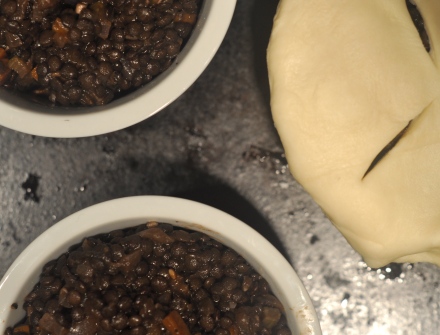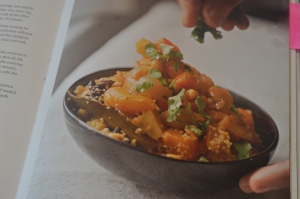The story behind this recipe for pasta with olives, garlic, and herbs goes like this: It was cold and I didn’t want to go out to the store. So I flipped through my cookbooks and scoured my favorite cooking sites for a recipe I could make with ingredients that I had on hand. Which brought me to this Cook’s Illustrated‘s recipe. (Note: You will need a subscription to access the original recipe, although you can see my adapted version below.)

The kitchen wizards at Cook’s Illustrated wrote two paragraphs about “why the recipe works” but let me focus on five words: “ingredients that would boost flavor.” And indeed, the dish is bursting with flavor. Briny Kalamata olives. Garlic. The kinda-sweet, kinda-savory intensity of sun-dried tomatoes in olive oil. Not to mention the punch of the basil, with a nice assist from some parsley, an under-rated herb as far as I’m concerned. But getting back to flavor, The Professor agreed with Cook’s Illustrated and gave the dish an A for taste.

“It’s not as satisfying as, say, the lentil minestrone soup,” he added, though he gave it an A- in that category. I should mention that I tossed some kale — parboiled and sliced into crinkly ribbons — into the dish, adding both color and a bit more substance to the meal. I suspect that, without the kale, the dish would have ended up in the B-range for satisfaction. 

On interestingness, it scored a B+. “In an odd way, the stronger the flavors, the harder it is to maintain interest,” said The Professor, always on the lookout for a paradox. Though, in truth, it’s no paradox: A recipe that combines different, compatible flavors, giving an eater a slightly different combination of tastes with every bite, is always going to be more interesting than a dish whose ingredients meld into a single, dominant flavor. But at least the bread crumbs, sprinkled on top of the pasta as it is served, added an interesting crunch.

In any case, an interesting dish isn’t necessarily a tasty one. And — if you like olives — you will love this easy pasta, which walked away with an A- grade overall.
Pasta with Olives, Garlic, Herbs – and Greens
Adapted from a Cook’s Illustrated recipe
Ingredients
5 tablespoons extra virgin olive oil
4-6 medium cloves garlic, minced or pressed through garlic press
1 tablespoon tomato paste
1/4 – 1/2 teaspoon hot red pepper flakes
1/4 cup oil-packed sun-dried tomatoes, drained, rinsed, patted dry, and cut into thin strips
1 cup Kalamata olives, rinsed and coarsely chopped
2 large slices white sandwich bread, torn into quarters
1 3/4 teaspoons salt
1 pound rigatoni or other short pasta
1 bunch kale or other dark leafy green
1 cup finely grated Parmesan
3 tablespoons fresh parsley leaves, chopped
1 1/2 cups lightly packed fresh basil leaves, roughly torn
ground black pepper
Instructions
1) Combine 3 tablespoons olive oil, 1 tablespoon garlic, tomato paste, red pepper flakes, sun-dried tomatoes, and olives in a medium bowl.
2) Put a pot of water on to boil. Add remaining salt and parboil the kale for 3-4 minutes. Cool, squeeze dry, and slice into thin ribbons.
3) Pulse bread in food processor until coarsely group, about 16 one-second pulses.
4) Heat remaining olive oil in a saute pan over medium heat until shimmering. Add the bread crumbs and stir until they begin to brown. Add the rest of the garlic, stirring regularly until the garlic is fragrant and the bread crumbs are golden brown. Transfer to plate and let cool.Wipe out the pan.
5) Return water to a boil and add the pasta.
6) While pasta is cooking, add the olive mixture to the pan. Cook until the mixture is rusty red, about 4-6 minutes. Add 3/4 cup water from the pasta pot to the olive mixture and simmer for two minutes. Add the kale and stir to coat. Then remove pan from heat.
7) When pasta is just shy of al dente, drain, reserving 1/2 cup of the cooking water. Add olive mixture to pasta and toss over medium heat until the pasta absorbs most of the liquid, about 2 minutes. Stir in 1/2 cup Parmesan and adjust consistency with reserved pasta water.
7) Remove pan from heat and stir in herbs. Adjust seasoning with pepper. Serve topped with remaining Parmesan cheese the bread crumbs.

























